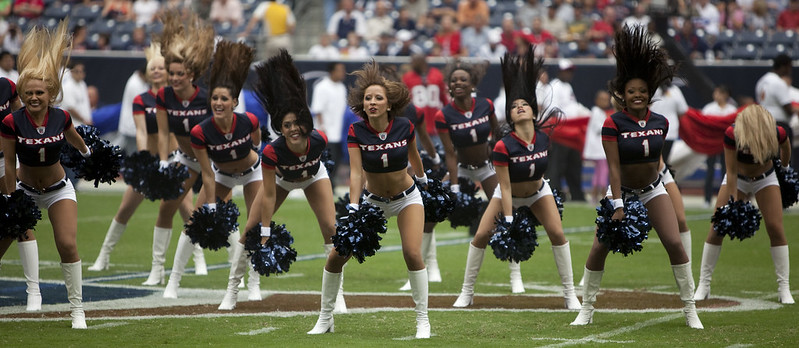In an all-too-familiar story for working women, Super Bowl cheerleaders are victims of low pay, long hours, zero benefits and near-impossible standards of sexiness and appearance not applied to male-dominated jobs.
Updated Feb. 8, 2021, at 7:15 a.m. PT.

The much-hyped, Super-men’s-fantasy Super Bowl came and went, with the Tampa Bay Buccaneers defeating the Kansas City Chiefs. The tradition of the game is unlike any other American sporting event—spawning parties, fanfare and an eye-popping TV broadcast where the commercials and halftime show are just as much of an attraction for the more than 100 million fans who watch.
But because of COVID, one super sexy (and super sexist) element was absent this year: Cheerleaders were not part of the hoopla. Voyeur types undoubtedly missed the crotch and chest shots, and less prurient fans didn’t get to see the top-notch precision drilling and dancing.
Though the cheerleaders weren’t on the field, you can watch them from a very different angle on several streaming services (including Amazon, iTunes and more): Last month, Independent Lens from PBS unveiled an eye-opening look at what’s behind the scenes of all that glitz and glamour. A Woman’s Work: The NFL’s Cheerleader Problem by multinational film maker Yu Gu highlights the continued fight to end the NFL’s exploitation of these women.
It’s an all-too-familiar story for working women—low pay, long hours, zero benefits and near-impossible standards of sexiness and appearance not applied to male-dominated jobs. To top it all off, this particular tale also includes not just “the usual” discrimination, but outright wage theft.
Through the stories of two women who took on the league—Lacy, a former cheerleader for the Oakland Raiders and mother of three, and Maria, a former Buffalo Bills cheerleader—A Woman’s Work paints a vivid picture systemic sex discrimination and pay practices over the 50 years the NFL has employed cheerleaders. They have been historically underpaid, with some earning as little as $5 an hour, and others no salary at all—only a flat fee per game, and no pay for performances at mandatory events or extensive rehearsal time.
The suit was filed in January 2014 alleging that cheerleaders were paid less than minimum wage—just $125 a game day in a single paycheck delivered at the end of the season. They were also denied overtime pay, despite working nine-hour days in grueling practices, all the while not being reimbursed for business expenses like uniforms from 2010 to 2014.
Additionally, the complaint cited docked pay for petty infractions like wearing the wrong shade of nail polish or bringing the wrong pom-poms to practice. And, oh yeah—cheerleaders were subject to a weekly “jiggle test” to assess every inch of their body and given a list of rules, including how to wash their “intimate areas.”
As more women joined to form a class action, 90 former Oakland Raiders cheerleaders received a $1.25 million settlement for fair pay later in 2014. It took another three years for the women to actually see any money.
But the fight was not over. The initial suit had a domino effect, as cheerleaders from the Cincinnati Bengals, New York Jets and Tampa Bay Buccaneers followed with legal action. The lawsuits sparked a national conversation concerning the exploitation of women in sports.
Bypassing the individual team route, in 2017 a group of former cheerleaders filed a class action lawsuit against the NFL as a whole, alleging the league and 26 member teams actively conspired to underpay them and keep them from negotiating better salaries. The lawsuit pointed out the differences between the salaries of NFL cheerleaders and team mascots, who earn between $25,000 and $60,000 per year, often with benefits.
Suits continue to rain down. Five cheerleaders for the Houston Texans sued in 2018, and in 2019 the Dallas Cowboys settled a sex discrimination in pay suit with a former cheerleader alleging she was paid below minimum wage.
Five months ago, attorneys notified the Washington Football Team of their intent to sue over lewd videos the team has produced out of outtakes from the cheerleaders’ 2008 and 2010 swimsuit calendar shoots that include partial nudity. Now in their 30s and 40s, with careers and children, the dozens of ex-cheerleaders who appear in the videos are still coping with a painful reckoning about their seasons with the NFL franchise, and terrified the footage will show up online.
Despite continuring litigation, seven years after the first suit no real solution to the problem is in sight. Obviously piecemeal individual and small group action is not the answer. A league-wide union could remedy the unfair employment practices cheerleaders face, but right now there’s no evidence that they’re seriously considering forming one.
Attorneys for Oakland group touted the settlement, this way: “Our clients have now been paid the equivalent of minimum wage for all of the hours they worked and have been reimbursed for their out-of-pocket expenses.” That great victory? Nine bucks an hour in California.
The minimum remains $7.50 nationally. Rah. Rah. Rah.
You may also like:





